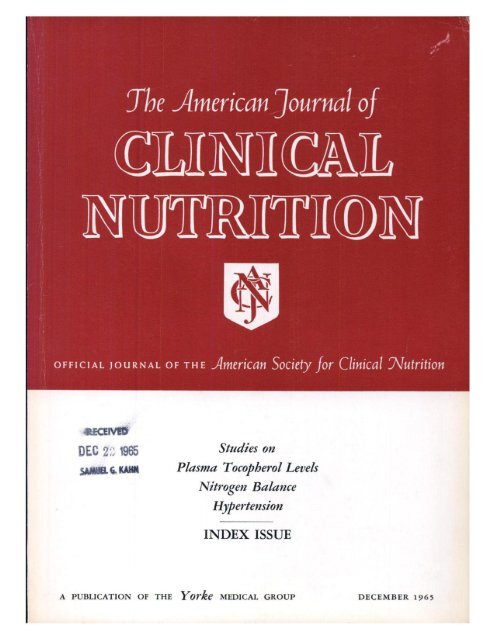Relationship of healthy lifestyle with healthy aging and the mediation by plasma proteins: a prospective cohort study
IF 6.5
1区 医学
Q1 NUTRITION & DIETETICS
引用次数: 0
Abstract
Background
Lifestyle factors have been widely associated with various major chronic diseases (MCDs) and life expectancy.
Objectives
Our study aimed to investigate the relationship of a healthy lifestyle with the odds of healthy aging and the mediating role of plasma proteins.
Methods
We included 26,774 participants from UK Biobank aged 64 y or older who were free of 15 MCDs at baseline. Healthy aging was defined as survival to age 80 without developing MCDs at the end of follow-up. According to a composite score of 7 lifestyle factors, the participants were grouped as having healthy (6 or 7 healthy lifestyle factors), intermediate (3–5 healthy lifestyle factors), or unhealthy (0–2 healthy lifestyle factors) lifestyles. Multivariable logistic regression models were used to evaluate the association of lifestyle categories with the odds of healthy aging. In a subsample (n = 3231), proteomic signatures of healthy lifestyle were identified and their potential mediation on the relationship of healthy lifestyle with healthy aging was assessed.
Results
A total of 16,269 participants achieved healthy aging. Compared with an unhealthy lifestyle, a healthy lifestyle was associated with 117% (95% CI: 95%, 141%) higher odds of healthy aging, as well as lower risks of all-cause mortality and various MCDs. There were 879 plasma proteins associated with a healthy lifestyle, largely involving the pathways associated with immune-inflammatory responses and lipid metabolism and atherosclerosis. There were 26 proteins that had the strongest correlations with healthy lifestyle (absolute value of effect size >0.15), among which 13 proteins were found to significantly explain 10.9%–30.7% of the relationship between healthy lifestyle and healthy aging. Fatty acid-binding protein 4, adrenomedullin, and hepatocyte growth factor were the leading mediators.
Conclusions
A healthy lifestyle is associated with substantially higher odds of healthy aging, potentially through the regulation of specific circulating proteins.
健康生活方式与健康衰老的关系及血浆蛋白介导的前瞻性队列研究
背景:生活方式因素与各种主要慢性疾病(MCDs)和预期寿命广泛相关。目的:探讨健康生活方式与健康衰老的关系及血浆蛋白在其中的中介作用。方法:我们纳入了26,774名来自UK Biobank的64岁或以上的参与者,他们在基线时没有15种mcd。健康老龄化被定义为在随访结束时存活至80岁而未发生mcd。根据七个生活方式因素的综合得分,参与者被分为健康(6或7个健康生活方式因素),中等(3-5个健康生活方式因素)或不健康(0-2个健康生活方式因素)的生活方式。采用多变量logistic回归模型评估生活方式类别与健康老龄化几率的关系。在一个亚样本(n = 3231)中,我们确定了健康生活方式的蛋白质组学特征,并评估了它们在健康生活方式与健康老龄化关系中的潜在中介作用。结果:16269人实现健康老龄化。与不健康的生活方式相比,健康的生活方式与健康衰老的几率高117% (95% CI: 95%-141%)相关,并与全因死亡率和各种mcd的风险降低相关。有879种血浆蛋白与健康生活方式相关,主要涉及与免疫炎症反应、脂质代谢和动脉粥样硬化相关的途径。有26种蛋白质与健康生活方式相关性最强(效应值绝对值>0.15),其中13种蛋白质对健康生活方式与健康衰老关系的解释率为10.9% ~ 30.7%。脂肪酸结合蛋白4、肾上腺髓质素和肝细胞生长因子是主要的介质。结论:健康的生活方式与健康衰老的几率高得多有关,可能是通过调节特定的循环蛋白来实现的。
本文章由计算机程序翻译,如有差异,请以英文原文为准。
求助全文
约1分钟内获得全文
求助全文
来源期刊
CiteScore
12.40
自引率
4.20%
发文量
332
审稿时长
38 days
期刊介绍:
American Journal of Clinical Nutrition is recognized as the most highly rated peer-reviewed, primary research journal in nutrition and dietetics.It focuses on publishing the latest research on various topics in nutrition, including but not limited to obesity, vitamins and minerals, nutrition and disease, and energy metabolism.
Purpose:
The purpose of AJCN is to:
Publish original research studies relevant to human and clinical nutrition.
Consider well-controlled clinical studies describing scientific mechanisms, efficacy, and safety of dietary interventions in the context of disease prevention or health benefits.
Encourage public health and epidemiologic studies relevant to human nutrition.
Promote innovative investigations of nutritional questions employing epigenetic, genomic, proteomic, and metabolomic approaches.
Include solicited editorials, book reviews, solicited or unsolicited review articles, invited controversy position papers, and letters to the Editor related to prior AJCN articles.
Peer Review Process:
All submitted material with scientific content undergoes peer review by the Editors or their designees before acceptance for publication.

 求助内容:
求助内容: 应助结果提醒方式:
应助结果提醒方式:


